Eridu Genesis, also called the Sumerian Creation Myth, Sumerian Flood Story and the Sumerian Deluge Myth, [1] [2] offers a description of the story surrounding how humanity was created by the gods, how the office of kingship entered human civilization, the circumstances leading to the origins of the first cities, and the global flood. [3]
Other Sumerian creation myths include the Barton Cylinder, the Debate between sheep and grain and the Debate between Winter and Summer, also found at Nippur. [4] Other flood myths appear in the Epic of Gilgamesh and the Genesis creation narrative.
The story is known from three fragments representing different versions of the narrative. One is a tablet excavated from the ancient Sumerian city known as Nippur. This tablet was discovered during the Expedition of the University of Pennsylvania in 1893, and the creation story was recognized by Arno Poebel in 1912. It is written in the Sumerian language and is dated to around 1600 BC. [1] The second fragment is from Ur, also written in Sumerian and from the same time period. The third is a bilingual Sumerian-Akkadian fragment from the Library of Ashurbanipal ca. 600 [5]
In 2018, a new fragment of the Eridu Genesis story was published. [6]
The first 36 lines of the primary tablet from Nippur are lost, although they can be inferred to have discussed the creation of man and animals, and likely spoke about the dissolute existence of mankind prior to civilization (as is indicated by the fragment from Ur). The surviving portion begins with a monologue from Nintur, the goddess who birthed mankind, where she calls humans from a vagrant existence as nomads to build cities, temples, and become both sedentary and civilized. [7] After the monologue, there is another missing section that only resumes after another 36 lines, and at this point humans are still in a nomadic state; the missing section may have spoken of an initial unsuccessful attempt by humans to establish civilization. [8] When the text resumes, Nintur is still planning on providing kingship and organization to humans. Then, the first cities are named (beginning with Eridu, whose leadership Nintur placed under Nudimmud), then Badtibira, Larak, Sippar, and finally Shuruppak. The cities were established as distributional (not monetary) economies. Another lacuna (missing section) of 34 lines proceeds. The fragment from the library of Ashurbanipal, as well as independent evidence from the Sumerian King List, suggests this section included the naming of more cities and their rulers. [9] What occurs next is a statement that humans began to make noises that annoyed the gods: Enlil in particular was entirely unable to sleep due to humanity and made the radical decision to deal with this by destroying humanity with a flood. The god Enki informs one human, Ziusudra (likely a priest), of this decision and advises him to build a boat to save both himself and one couple of every living creature. Ziusudra builds the boat, boards it with his family and the animals, and the gods unleash the flood, although the exact phrasing is unclear as another lacuna appears in this section. Mankind and the rest of life survives, and again, the text breaks off. [10]
Before the missing section, the gods have decided to send a flood to destroy humanity. Enki, god of the underworld sea of fresh water and equivalent of Babylonian Ea, warns Ziusudra, the ruler of Shuruppak, to build a large boat, though the directions for the boat are also lost.
When the tablet resumes, it describes the flood. A terrible storm rages for seven days and nights. "The huge boat had been tossed about on the great waters." Then Utu (Sun) appears and Ziusudra opens a window, prostrates himself, and sacrifices an ox and a sheep.
After another break, the text resumes with the flood apparently over, and Ziusudra prostrating himself before An (Sky) and Enlil (Lordbreath), who give him "breath eternal" for "preserving the animals and the seed of mankind". The remainder is lost. [11]
The Epic of Ziusudra adds an element at lines 258–261 not found in other versions, that after the river flood [12] "king Ziusudra ... they caused to dwell in the land of the country of Dilmun, the place where the sun rises". In this version of the story, Ziusudra's boat floats down the Euphrates river into the Persian Gulf (rather than up onto a mountain, or up-stream to Kish). [13] The Sumerian word KUR in line 140 of the Gilgamesh flood myth was interpreted to mean "mountain" in Akkadian, although in Sumerian, KUR means "mountain" but also "land", especially a foreign country, as well as "the Underworld".
Some modern scholars believe the Sumerian deluge story corresponds to localized river flooding at Shuruppak (modern Tell Fara, Iraq) and various other cities as far north as Kish, as revealed by a layer of riverine sediments, radiocarbon dated to c. 2900 BCE, which interrupt the continuity of settlement. Polychrome pottery from the Jemdet Nasr period (c. 3000–2900 BCE) was discovered immediately below this Shuruppak flood stratum. None of the predynastic antediluvian rulers have been verified as historical by archaeological excavations, epigraphical inscriptions or otherwise, but the Sumerians purported them to have lived in the mythical era before the great deluge. [14]

Enlil, later known as Elil, is an ancient Mesopotamian god associated with wind, air, earth, and storms. He is first attested as the chief deity of the Sumerian pantheon, but he was later worshipped by the Akkadians, Babylonians, Assyrians, and Hurrians. Enlil's primary center of worship was the Ekur temple in the city of Nippur, which was believed to have been built by Enlil himself and was regarded as the "mooring-rope" of heaven and earth. He is also sometimes referred to in Sumerian texts as Nunamnir. According to one Sumerian hymn, Enlil himself was so holy that not even the other gods could look upon him. Enlil rose to prominence during the twenty-fourth century BC with the rise of Nippur. His cult fell into decline after Nippur was sacked by the Elamites in 1230 BC and he was eventually supplanted as the chief god of the Mesopotamian pantheon by the Babylonian national god Marduk.
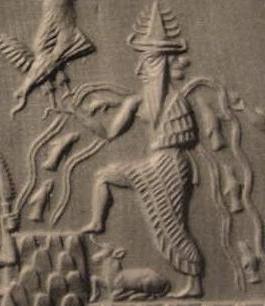
Enki is the Sumerian god of water, knowledge (gestú), crafts (gašam), and creation (nudimmud), and one of the Anunnaki. He was later known as Ea or Ae in Akkadian (Assyrian-Babylonian) religion, and is identified by some scholars with Ia in Canaanite religion. The name was rendered Aos in Greek sources.

Noah appears as the last of the Antediluvian patriarchs in the traditions of Abrahamic religions. His story appears in the Hebrew Bible, the Quran and Baha'i writings. Noah is referenced in various other books of the Bible, including the New Testament, and in associated deuterocanonical books.
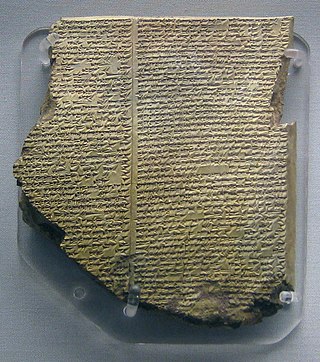
The Epic of Gilgamesh is an epic poem from ancient Mesopotamia. The literary history of Gilgamesh begins with five Sumerian poems about Gilgamesh, king of Uruk, some of which may date back to the Third Dynasty of Ur. These independent stories were later used as source material for a combined epic in Akkadian. The first surviving version of this combined epic, known as the "Old Babylonian" version, dates back to the 18th century BC and is titled after its incipit, Shūtur eli sharrī. Only a few tablets of it have survived. The later Standard Babylonian version compiled by Sîn-lēqi-unninni dates to somewhere between the 13th to the 10th centuries BC and bears the incipit Sha naqba īmuru. Approximately two-thirds of this longer, twelve-tablet version have been recovered. Some of the best copies were discovered in the library ruins of the 7th-century BC Assyrian king Ashurbanipal.

Noah's Ark is the ship in the Genesis flood narrative through which God spares Noah, his family, and examples of all the world's animals from a global deluge. The story in Genesis is based on earlier flood myths originating in Mesopotamia, and is repeated, with variations, in the Quran, where the Ark appears as Safinat Nūḥ and al-fulk. The myth of the global flood that destroys all life begins to appear in the Old Babylonian Empire period. The version closest to the biblical story of Noah, as well as its most likely source, is that of Utnapishtim in the Epic of Gilgamesh.

Ziusudra of Shuruppak is listed in the WB-62 Sumerian King List recension as the last king of Sumer prior to the Great Flood. He is subsequently recorded as the hero of the Eridu Genesis and appears in the writings of Berossus as Xisuthros.

A flood myth or a deluge myth is a myth in which a great flood, usually sent by a deity or deities, destroys civilization, often in an act of divine retribution. Parallels are often drawn between the flood waters of these myths and the primeval waters which appear in certain creation myths, as the flood waters are described as a measure for the cleansing of humanity, in preparation for rebirth. Most flood myths also contain a culture hero, who "represents the human craving for life".

Anzû, also known as dZû and Imdugud, is a monster in several Mesopotamian religions. He was conceived by the pure waters of the Abzu and the wide Earth, or as son of Siris. Anzû was depicted as a massive bird who can breathe fire and water, although Anzû is alternately depicted as a lion-headed eagle.

Atra-Hasis is an 18th-century BC Akkadian epic, recorded in various versions on clay tablets, named for its protagonist, Atrahasis. The Atra-Hasis tablets include both a cosmological creation myth and one of three surviving Babylonian flood myths. The name "Atra-Hasis" also appears, as a king of Shuruppak in the times before a flood, on one of the Sumerian King Lists.
Shuruppak, modern Tell Fara, was an ancient Sumerian city situated about 55 kilometres (35 mi) south of Nippur and 30 kilometers north of ancient Uruk on the banks of the Euphrates in Iraq's Al-Qādisiyyah Governorate. Shuruppak was dedicated to Ninlil, also called Sud, the goddess of grain and the air.
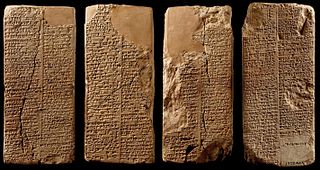
Alulim was a mythological Mesopotamian ruler, regarded as the first king ever to rule. He is known from the Sumerian King List, Ballad of Early Rulers, and other similar sources which invariably place him in Eridu and assign a reign lasting thousands of years to him. The tablet of Old Babylonian period from Ur describing the divine appointment of Alulim by the gods notes that he was chosen among "vast and many people," and appointed by gods for the "shepherdship of the entirety of the many people". Another myth describing his appointment by the gods and incantations treating him as the creator of insects are also known. He is absent from Early Dynastic sources, and he is considered fictional by Assyriologists. His name was preserved in later Greek, Arabic and Persian works.

The Gilgamesh flood myth is a flood myth in the Epic of Gilgamesh. It is one of three Mesopotamian Flood Myths alongside the one including in the Eridu Genesis, and an episode from the Atra-Hasis Epic. Many scholars believe that the flood myth was added to Tablet XI in the "standard version" of the Gilgamesh Epic by an editor who used the flood story from the Epic of Atra-Hasis. A short reference to the flood myth is also present in the much older Sumerian Gilgamesh poems, from which the later Babylonian versions drew much of their inspiration and subject matter.
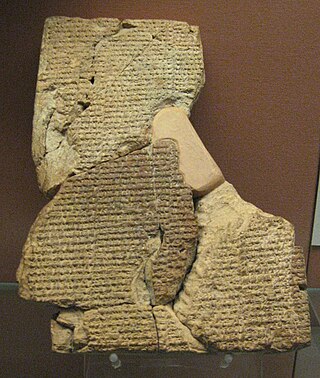
Ut-napishtim is a legendary king of Shuruppak in southern Iraq, who survived the Flood by making a boat.

Apkallu or and Abgal are terms found in cuneiform inscriptions that in general mean either "wise" or "sage".

The Instructions of Shuruppak are a significant example of Sumerian wisdom literature. Wisdom literature, intended to teach proper piety, inculcate virtue, and preserve community standards, was common throughout the ancient Near East. Its incipit sets the text in great antiquity by : "In those days, in those far remote times, in those nights, in those faraway nights, in those years, in those far remote years." The precepts are placed in the mouth of a king Šuruppak (SU.KUR.RUki), son of Ubara-Tutu. Ubara-Tutu is recorded in most extant copies of the Sumerian king list as being the final king of Sumer prior to the deluge. Ubara-tutu is briefly mentioned in tablet XI of the Epic of Gilgamesh, where he is identified as the father of Utnapishtim, a character who is instructed by the god Ea to build a boat in order to survive the coming flood. Grouped with the other cuneiform tablets from Abu Salabikh, the Instructions date to the early third millennium BCE, being among the oldest surviving literature.

The "Debate between sheep and grain" or "Myth of cattle and grain" is a Sumerian creation myth, written on clay tablets in the mid to late 3rd millennium BC.

Enlil and Ninlil, the Myth of Enlil and Ninlil, or Enlil and Ninlil: The begetting of Nanna is a Sumerian creation myth, written on clay tablets in the mid to late 3rd millennium BC.

The Kesh temple hymn, Liturgy to Nintud, or Liturgy to Nintud on the creation of man and woman, is a Sumerian tablet, written on clay tablets as early as 2600 BCE. Along with the Instructions of Shuruppak, it is the oldest surviving literature in the world.

The Song of the hoe or the Creation of the pickax is a Sumerian creation myth, written on clay tablets from the last century of the 3rd millennium BCE.
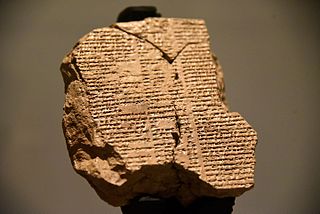
Mesopotamian mythology refers to the myths, religious texts, and other literature that comes from the region of ancient Mesopotamia which is a historical region of Western Asia, situated within the Tigris–Euphrates river system that occupies the area of present-day Iraq. In particular the societies of Sumer, Akkad, and Assyria, all of which existed shortly after 3000 BCE and were mostly gone by 400 CE. These works were primarily preserved on stone or clay tablets and were written in cuneiform by scribes. Several lengthy pieces have survived erosion and time, some of which are considered the oldest stories in the world, and have given historians insight into Mesopotamian ideology and cosmology.